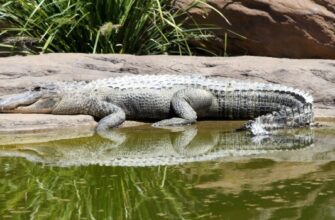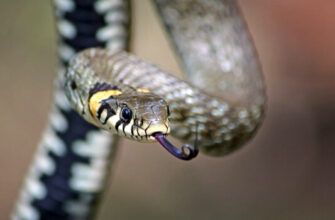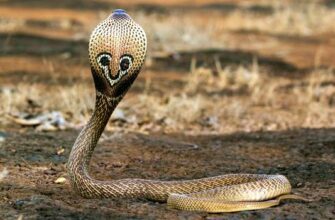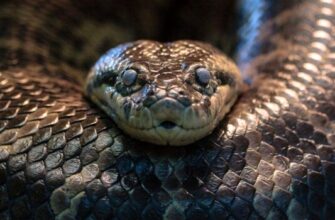Caiman is the oldest inhabitant on our planet, whose appearance has remained practically unchanged. The changing habitat and natural enemies of the caiman played a role in the formation of its adaptive features and peculiar character. Caiman is a representative of the predatory order Crocodiles, but has fundamental differences, thanks to which it can be easily recognized.
Origin of the species and description
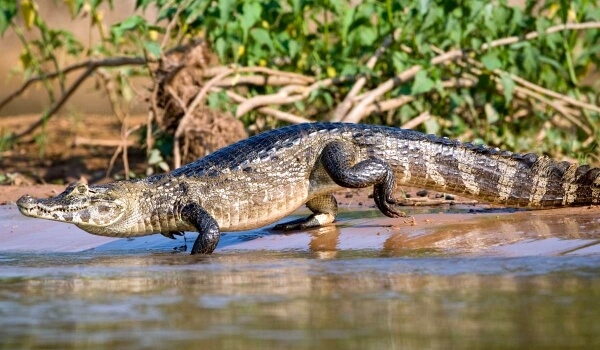
Photo: Caiman
In the origin of caimans, scientists agree that their ancient ancestors are extinct reptiles – pseudosuchia. They lived about 230 million years ago and gave rise to dinosaurs and crocodiles. Ancient caimans differed from modern representatives of the genus in longer legs and a short muzzle. About 65 million years ago, dinosaurs became extinct, and crocodiles, including caimans, were able to adapt and survive in new conditions.
Video: Caiman
The genus of caimans is part of the alligator family, a class of reptiles, but stands out as an independent unit due to the features of the external structure. On the belly of caimans, in the process of evolution, a bone frame was formed in the form of plates connected by movable joints. Such protective “armor” well protects caimans from the attack of predatory fish. Another distinctive feature of these reptiles is the absence of a bony septum in the nasal cavity, so their skull has a common nostril passage.
An interesting fact: “Caimans, unlike alligators and real crocodiles, do not have lacrimal glands in the structure of the eyes, so they cannot live in highly saline waters.
The body structure of caimans is adapted to life in aquatic conditions. To easily drift through the water and unexpectedly hit the prey, the body of the caiman is flattened in height, the head is flat with an elongated muzzle, short legs and a strong long tail. In the eyes there are special membranes that close when immersed in water. On land, these adjoiners can move fairly quickly, and juveniles can even gallop.
Fun fact: “Caimans can make sounds. In adults, this sound resembles the barking of a dog, and in caiman babies, it is the croaking of a frog.
The genus of caimans includes 5 species, two of which (Caiman latirostris and venecilensis) have already become extinct.
Currently, 3 species of caimans can be found in nature:
- Caiman crocodile or common, spectacled (has four subspecies);
- Broad-nosed or broad-nosed caiman (no subspecies);
- Paraguayan or piranha caiman, Yakarsky (no subspecies).
Appearance and Features
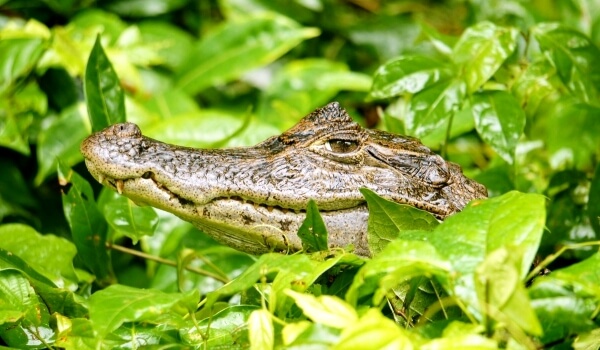
Photo: Crocodile caiman
Representatives of the three species of caimans are similar among themselves, but have individual external differences.
Crocodile caiman is characterized by such external signs:
- Dimensions – body length of males — 1.8-2 meters, and females – 1.2-1.4 meters;
- Body weight is in the range from 7 to 40 kg. The muzzle has an elongated shape with a narrowed front end. Between the eyes there are bone outgrowths that create the appearance of glasses, hence the name of this species. On the outer part of the eye there is a triangular ridge, inherited from the progenitors;
- There are 72-78 teeth in the mouth, the upper jaw covers the teeth of the lower one. On the lower jaw, the first and fourth teeth are quite large, due to which notches were formed on the upper jaw;
- The color of the adult varies from dark green to brown, and the young are yellow-green in color with contrasting spots on the body.
Interesting fact: “Crocodile caimans change color at low temperatures of your body to black. This ability of his skin is provided by pigment cells — melanophores.”
Compared to other species, the broad-faced caiman has the following characteristics:
- Dimensions – males up to 2 meters in length, but there are representatives up to 3.5 meters. Females are shorter;
- The muzzle of the caiman is wide and large, along it there are bone growths;
- There are no notches on the upper jaw for large teeth of the lower one, like in the crocodile caiman;
- Body – on the back there is a lot of dense ossified scales, and on the stomach there are several rows of bone plates;
- The color is olive green, but lighter. There are dark spots on the skin of the lower jaw.
The Paraguayan caiman has the following features of appearance:
- Dimensions – body length is often within 2 meters, but among males there are individuals of 2.5 – 3 meters;
- The structure of the jaw like a crocodile caiman;
- The body color is brown, varying between light and dark tones. Has dark brown stripes on the body and tail.
Where does the caiman live?
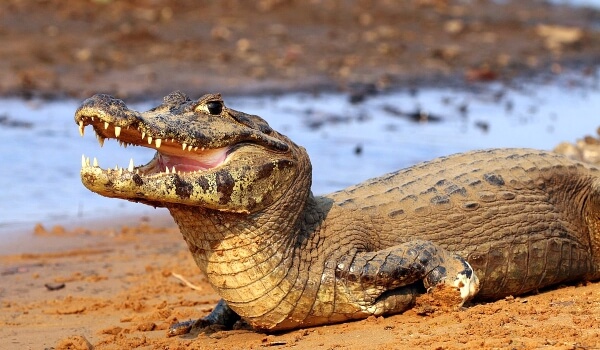
Photo: Caiman Animal
The habitat of these reptiles is quite wide and depends on the thermal preference of caimans. The territory of distribution of the crocodile caiman is tropical and subtropical reservoirs of South and Central America. It is found from Guatemala and Mexico to Peru and Brazil. One of its subspecies (fuscus) was relocated to the territory of certain American states bordering the Caribbean Sea (Cuba, Puerto Rico).
Crocodile caiman prefers reservoirs with stagnant fresh water, near small rivers and lakes , as well as wet lowlands. For a short time he can live in salt water, no more than two days.
The broad-faced caiman is more resistant to low temperatures, therefore it is found along the line of the Atlantic coast in the reservoirs of Brazil, in Paraguay, Bolivia, and northern Argentina. Its favorite habitat is wetlands and small river inlets with fresh, sometimes slightly salty water. It can also settle in ponds near people’s homes.
The Paraguayan caiman prefers to live in areas with a warm climate. It lives in the south of Brazil and Bolivia, in the north of Argentina, Paraguay in marshy lowlands. It can often be spotted among floating islands of vegetation.
What does a caiman eat?
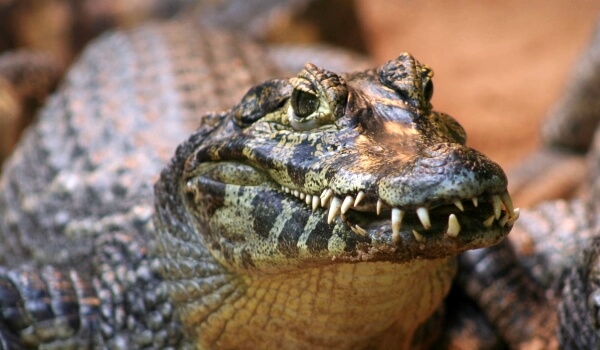
Photo: Caiman alligator
Caimans, unlike their larger predatory relatives are not adapted to eat large animals. This fact is due to the structure of the jaw, the small size of the body, as well as the initial fearfulness of these reptiles.
Living mainly in wetlands, caimans can profit from such animals:
- aquatic invertebrates and vertebrates;
- amphibians;
- small reptiles;
- small mammals.
Insects that land on water predominate in the diet of young animals. As they grow, they switch to eating larger prey – crustaceans, molluscs, river fish, frogs, small rodents. Adult individuals are able to feed themselves a medium-sized capybara, a dangerous anaconda, a turtle.
Caimans swallow their prey whole, without biting it. Turtles with their thick shells are considered an exception. For broad-faced and Paraguayan caimans, water snails are a particularly tasty delicacy. Due to this preference in nutrition, these reptiles are considered the orderlies of reservoirs, as they regulate the number of these mollusks.
Another name for the Paraguayan caiman is piranha, because it eats these predatory fish, thereby regulating their population. Cannibalism also occurs among caimans.
Character and lifestyle features
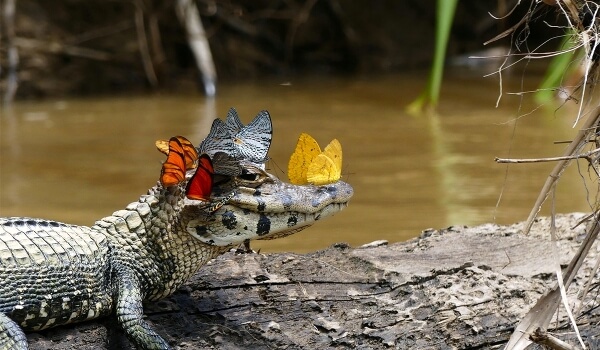
Photo: Caiman Animal
These reptiles live most often alone and can sometimes live in pairs or groups, usually during the breeding season. When dry times come, they gather in groups in search of bodies of water that have not yet dried up.
Interesting fact: “During a drought, some caimans burrow deep into the mud and hibernate.”
For the purpose of camouflage during the daytime, caimans prefer to live in the mud or among the thickets, where they can hide and quietly bask in the sun most of the time. Disturbed caimans will rapidly return to the water. Females come out to land to nest there and lay their eggs.
At night, as soon as dusk falls, these reptiles come out to hunt in their underwater world. When hunting, they sink completely underwater, only their nostrils and eyes protruding to the surface.
An interesting fact: “There are more rods than cones in the structure of the caiman’s eyes. Therefore, they can see perfectly at night.”
These reptiles have a relatively calm, peaceful and even timid character, therefore they do not attack people and large animals for the purpose of prey. This behavior is partly due to their small size. Caimans live from 30 to 40 years, life expectancy is shorter in captivity.
Social structure and reproduction
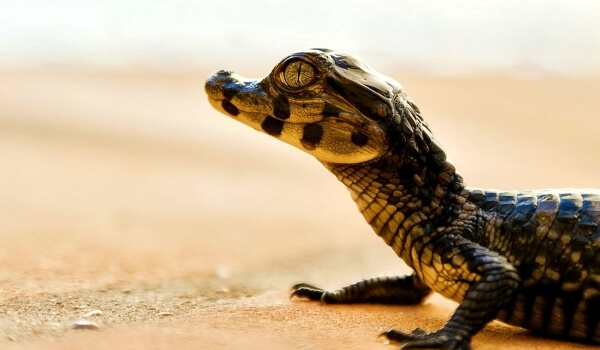
Photo: Caiman baby
In the caiman population, as structural unit, there is a hierarchy among males in terms of body size and puberty. That is, in a particular habitat, only the largest and most mature male is considered dominant and can breed. The rest of the males living in the same area with him have little chance of being allowed to breed.
Caimans are considered sexually mature when they have reached the body length of an adult individual at the age of 4 to 7 years. At the same time, females are smaller in size than males. A suitable period for procreation lasts from May to August. During the rainy season, females make nests for laying eggs, near the habitat in the bushes or under trees. Nests are formed from plants and clay, and sometimes they simply dig a hole in the sand.
To save offspring, the female can build several nests or team up with others to create a common nest, after which they can monitor it together. Sometimes even the male can look after the nest while the female hunts. One female lays 15-40 eggs the size of a goose or chicken egg. In order for individuals of both sexes to hatch in one clutch, the female lays eggs in two layers to create a temperature difference.
Embryo maturation occurs within 70-90 days. In March, little caimans are ready to be born. They emit “croaking” sounds and the mother begins to dig them out. Then in the mouth it transfers them to the reservoir. In the process of growing up, the young are always close to their mother, who protects them from external enemies. One female can protect not only her cubs, but also strangers. Young individuals actively grow the first two years, then their growth slows down. Larger and more active individuals immediately stand out in the group of growing caimans, they will later occupy the top in their adult hierarchy.
Natural enemies of caimans
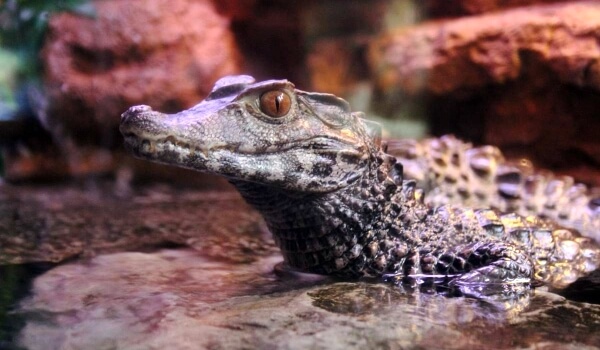
Photo: Cayman
Despite the fact that caimans are predatory animals, they themselves are part of the food chain of larger and more aggressive predators. All three types of caimans can become prey for jaguars, large anacondas, giant otters, packs of large stray dogs. Living in the same area with real crocodiles and black caimans (this is a South American crocodile), these small reptiles often become their victims.
After laying eggs, the female must make no small effort and patience to protect the nest and her eggs from large lizards that devastate up to a quarter of caimans’ nests. Nowadays, humans are also among the natural enemies of caimans.
Man has such a negative impact on the caimans population:
- Harms the habitat – this includes deforestation, pollution of water bodies with waste from hydroelectric power plants, plowing of new agricultural plots;
- Decrease in the number of individuals as a result of poaching activities. The skin of these reptiles is difficult to process for the manufacture of leather products, the only exception is the broad-faced species. Crocodile caimans, for their small size and peaceful disposition, are often caught for sale in private terrariums.
Interesting fact: “In 2013, caimans living in the Tortuguero National Park in Costa Rica were victims of pesticide poisoning that entered the Rio Suerte from banana plantations.”
Population and species status
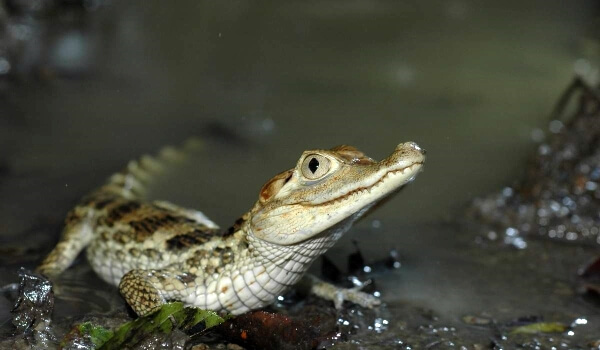
Photo: Little caiman
The number of individuals in the caiman population was significantly reduced in the middle of the 20th century as a result of uncontrolled capture and trade . This historical fact is due to the fact that by this time crocodiles with valuable skin types were on the verge of extermination. Therefore, people, in order to replenish the market of leather products with raw materials, began to hunt caimans, even though their skin is suitable for processing only from the sides of the body.
Caiman skin is less valued (about 10 times), but at the same time, a significant part of the world market is filled with it today. Despite the scale of the harmful human action, the caiman population has been preserved, thanks to measures to protect this genus of animals and their high adaptability to changing living conditions. In crocodile caimans, the approximate number of individuals in the population is 1 million, in broad-mouthed caimans – 250-500 thousand, and in Paraguayan this figure is much lower – 100-200 thousand.
Since caimans are predators, they play a regulatory role in nature. Eating small rodents, snakes, mollusks, beetles, worms, they are considered ecosystem cleaners. And thanks to eating piranhas, they maintain the population of non-predatory fish. In addition, caimans enrich shallow streams with nitrogen contained in the waste of the animal.
Protection of caimans
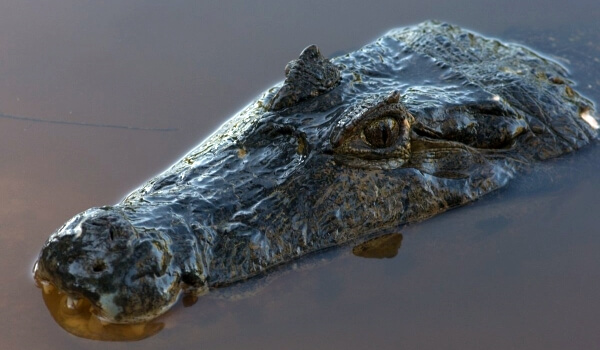
Photo: Cayman Red Book
All three species of caimans are under the animal protection program of the CITES trade convention. Since the population of crocodile caimans is higher, they are included in Appendix II of this Convention. According to the appendix, these species of caimans may be endangered by uncontrolled trade in their representatives. In Ecuador, Venezuela, Brazil, their species is under protection, and in Panama and Colombia, hunting for them is strictly limited. In Cuba and Puerto Rico, he was specially settled in local reservoirs for breeding.
On the other hand, the Apaporis common caiman, which lives in the southeast of Colombia, is included in Appendix I of the CITES Convention, that is, this species is endangered and its trade is possible only as an exception. There are no more than one thousand representatives of this subspecies. The broad-faced species of caimans is also included in CITES Appendix I, rather because its skin is the most suitable for making leather products from it. In addition, they often try to pass it off as a high-quality fake of alligator skin.
The Paraguayan species of caimans is listed in the International Red Book. In order to increase its population, special programs have been developed that are being implemented in Bolivia, Argentina, and Brazil. In Argentina and Brazil, they are trying to breed a population of these unpretentious reptiles, creating conditions for them in “crocodile” farms. And in Bolivia, they adapt to their breeding in natural conditions.
Caiman are rather unusual animals living on our planet. They are interesting for their history, bizarre and, at the same time, alarming appearance, as well as an unpretentious way of life. Since they are the most ancient inhabitants of the Earth, they have the right to respect and support from humanity.

